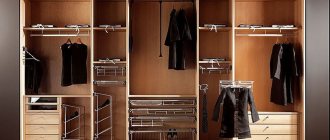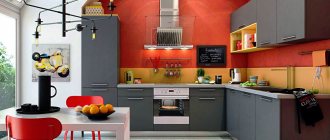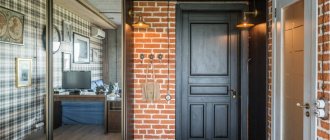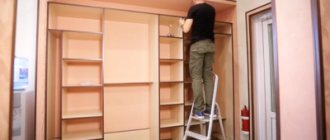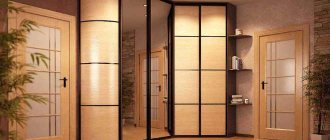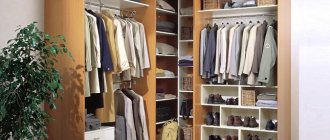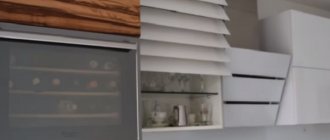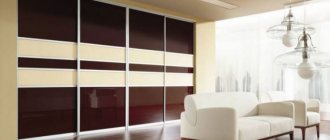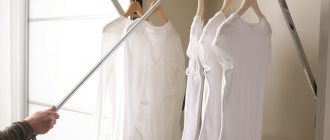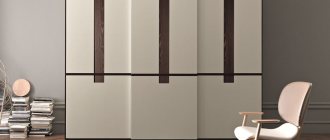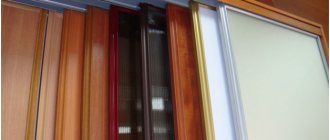In a rare apartment you will not find a wardrobe that allows you to store a lot of things and save space due to sliding doors. To assemble any wardrobe you need skillful hands, a diagram and a set of parts. The set includes large components: doors, sides, shelves. And to connect them together you need small, but no less important components.
Fittings for sliding wardrobes are those small details without which it will not be possible to make full-fledged furniture. Otherwise, it will not fully perform its intended functions. The brand and model of the part affects the quality and service life of the cabinet. Let's consider the types of guides, rollers, stoppers, sliding systems and auxiliary mechanisms. Let's talk about the rules for choosing components.
TopLine XL set for two doors - silent mechanism EB 30
Purpose
Fittings - elements for connecting parts, lifting mechanisms, devices for expanding the functionality of furniture. This includes hinges, handles, holders, closers.
The accessories are intended for:
- body assemblies;
- installation of sliding doors;
- efficient operation of boxes;
- cabinet filling;
- fixing door leaves, protecting against swinging open or spontaneous closing.
For example, when assembling a cabinet, you can make changes to the filling and diversify the standard set with additional fittings, if space has been provided in advance for these purposes.
Selection of accessories
Choosing good hardware for compartment doors is quite difficult. This is due to the fact that the market offers a huge variety of doors and components of varying quality. All structural elements of compartment doors must have excellent characteristics, since if they do not work correctly, the doors will simply stop opening.
To make the right choice, you need to understand a simple principle - good things don’t come cheap. This fully applies to the issue of choosing accessories. If the materials from which compartment door components are made are of insufficient quality, breakdown is inevitable.
It should be understood that the operating mechanism of such doors, although not complicated, is quite demanding in terms of operating conditions. If you use the doors carelessly, they will quickly become unusable.
Before purchasing, you need to study reviews from consumers who already have experience with such doors. If the majority of reviews are good, you can safely purchase accessories from those manufacturers who have been given a positive rating.
So, fittings for interior compartment doors are required for installation, since some of its elements, such as rollers and guides, are fundamental to the entire structure. Doors cannot be used without fittings, which makes the right choice important. When making a choice, you should pay attention to the quality of the fittings, since it is this that determines the durability of the entire structure. If you approach the issue wisely, compartment doors will last a long time and will not cause problems.
List of components
The standard set of furniture fittings for cabinets with sliding doors includes the parts presented in the table:
| Guide profile - fixed in the upper and lower parts of the body, firmly holds the doors in a vertical position and allows them to slide to the sides. |
| A door profile is a frame that frames the doors around the perimeter. |
| Rollers - installed on the door, facilitate easy opening and closing. |
| Stoppers—attached on both sides of the profile, slow down the movement of the leaf as it approaches the walls, and fix the position of the doors. |
| The seal is a soft tape that is glued to the side walls of the doors, dampens noise and vibration, prevents dust from entering the cabinet and protects the doors from knocking on the body. |
| A sliding system is a type of mechanism for moving doors. |
| Handles are mortise, the fastening of which occurs by milling the facade. They are made in round, oval or rectangular shapes. To save money or make it impossible to insert, the role of handles is often played by the door profile. |
What fittings are needed for a wardrobe?
Modern sliding wardrobes significantly save space, as they are built into niches and installed at the full height of the room. The width and depth of the cabinets are selected individually to suit the parameters of each room, as are the sizes of fittings for sliding wardrobes. During use, it is possible to supplement the finished cabinet with new elements. Diverse in purpose, fittings for sliding wardrobes with sliding doors are used for several purposes:
- for a mechanism for opening and closing doors;
- for installing drawers;
- for fixing doors;
- for organizing the interior space of the cabinet.
Pull-out fittings
The cabinet is filled with pull-out elements that are mounted on the following types of guides:
| Roller ones are the most popular on the cabinet furniture market. Allows loads up to 25 kg. They come with a door closer included. | |
| Ball - movement in them is carried out due to balls in the profile. The advantage is easy opening of the drawers and a variety of sizes. | |
| Metaboxes are a system with roller guides and drawer sides made of steel or plastic. Can be extended fully or partially. They come in different sizes and differ in filling elements. | |
| Tandems are guides that are hidden inside the drawer. When using such a system, the entire cabinet space is used with a gap of no more than 4 mm. The advantages include noiselessness and a variety of components. There is only one drawback - high cost. |
The filling depends on the functions of the cabinet and your budget.
Moving and guiding elements
Fittings for compartment doors are presented in a wide variety. One of the main types of fittings is guides. The door moves along them. The length of the guides is selected based on the width of the doorway in which they will be installed.
To ensure that the canvas is held on the guides and can move along them, rollers are used. They can safely be called a key design element, since without them the doors could not open and close. The roller system allows the doors to move silently along the guides. The most reliable systems are made of aluminum. In addition, they are the lightest. Aluminum rollers will not form rust and are not subject to deformation.
The most unreliable roller systems are made of plastic. They are not very popular because they quickly break down. In addition, for operation it is necessary to install hooks. Plastic creates additional friction, the elements do not work as smoothly and are noisy. Another disadvantage is that the plastic is noticeable when installed together with a glass door.
Fittings for compartment doors, which are produced by various manufacturers, including roller designs, may differ both structurally and functionally.
The sliding door guides have the following features:
- They make it possible to adjust the height of the canvas, which is really important in systems that are installed between rooms;
- Installation of fasteners can be carried out directly on the canvas. As a rule, fasteners are mounted on the surface of the door in cases where an image is applied to it, which should look like a single whole;
- To create a unified style in the interior, components can be decoratively processed - tinted or rubberized;
- In order to hold a heavy canvas, components can be reinforced.
It is also important how the structure will be installed. Rollers from some manufacturers can only be installed on a specific profile using guides of a specific type and manufacturer. Fastenings can be hidden or open.
To ensure that the sliding door is securely fixed, a stopper is used. As a rule, it is made of steel in the form of a spring and securely fixes the doors in any position.
Filling elements
For dressing rooms, fittings are produced that allow you to neatly place clothes, shoes and other items. The convenience of the closet depends on it. Let's consider the main details of such accessories:
| Horizontal rod - a metal pipe designed for hangers, which is attached between the walls of the cabinet. | |
| Pull-out hangers are installed across the cabinet. They look like barbells and can be stationary or retractable. | |
| A retractable trouser holder for a wardrobe is attached to its rear or side walls and comes in several configurations. A model in the form of pins is considered convenient. | |
| Pantograph. Installed in large wardrobes up to the ceiling without mezzanines, when you need to place things in two rows. At the lower level, clothes are hung on static rods. On the top one there are hangers hanging on a pantograph. This is convenient for people of any height. | |
| Pull-out mesh baskets. A modern version of drawers that provides ventilation for things. | |
| Shoe shelves are similar to conventional drawers, but differ in partitions for rational placement of shoes. | |
| Belt holder - equipped with hooks for hanging by the buckle. | |
| The tie holder is a strip with small plastic hooks. | |
| Iron holder - wire retainer can withstand the maximum possible heating temperature of the soleplate of 205°C. Fastened with self-tapping screws in a separate compartment of the cabinet. | |
| The vacuum cleaner hose holder is also made of wire and allows for convenient hanging storage. |
When choosing what to fill your closet, think in advance about what will be stored in it and in what quantity.
If desired, locks can be installed on the cabinet doors to hide the contents from children. For example, the Lubby company produces latches and locks that limit the opening of drawers.
Filling for sliding wardrobes
A spacious wardrobe is useful in the house to store several sets of clothes for the whole family, which is why organizing the internal space is very important. A variety of wardrobe parts allow you to conveniently store different things - ties, socks, trousers, shirts, dresses, shoes and so on. For this purpose, special functional fittings are used:
- shelves;
- bars for placing clothes on hangers;
- drawers and baskets with a sliding mechanism;
- racks and drawers for ties;
- pantographs;
- tie racks;
- retractable pantographs.
Selection rules
When purchasing fittings for a wardrobe, look at the quality of workmanship - replacing it in the future will not be easy. The service life of moving elements, the load on shelves, and ease of use depend on the quality of components. The rollers must withstand repeated door openings, and the sliding mechanism must operate smoothly and effortlessly.
When purchasing components, take into account the manufacturer’s reputation and reviews of models; do not skimp on parts. Corners, hooks, door handles, profiles for facades, in addition to their main function, also perform a decorative function.
Expert opinion
Bashir Rabadanov
Technologist at the furniture company Woodband
Buy all parts from one manufacturer. This will protect against possible inconsistencies between the elements of the fittings, and therefore prevent inconvenience during operation.
The table shows manufacturers of reliable accessories whose products are on the Russian market. The rating is based on customer reviews.
| Manufacturer | Description | Made-Box rating |
| TOTAL | A company offering a huge selection of parts - hinges, boxes, handles, hangers. | 2 |
| ARISTO | A leading supplier of components with a network of stores across Russia. | 5 |
| COMMANDER | It produces fittings in two directions - luxury and standard. Steel profiles are used in budget cabinet models. | 3 |
| LUCIDO | Turkish manufacturer of sliding wardrobe mechanisms | 1 |
| HETTICH | A German company with a subsidiary in Russia. Operating for over 100 years. Hettich fittings are distinguished by their durability, consistently high quality and wide range. | 5 |
| BLUM | An Austrian company produces retractable systems and lifting mechanisms. | 2 |
| STANLEY | American manufacturer of furniture and accessories. Stanley specializes in door rollers; the company’s popularity was brought by its “anti-jump” technology, which ensures doors move without distortion. | 4 |
Types of fittings for sliding wardrobes
Sliding wardrobes can be built-in, corner, cabinet and radius. Depending on the type of furniture, different fittings for sliding wardrobes are used. Its choice depends on various factors, for example, the material of manufacture, its shape, the number of doors, and so on. The standard set of furniture fittings for sliding wardrobes is as follows:
- Profiles of various types and materials.
- Guide rails along which the doors “ride”.
- Rollers that move door leaves.
- Stoppers for fixing the desired position of the door.
- Seals to reduce the risk of damage to the cabinet body.
- Sliding mechanism for the movement of the sashes.
Rollers for sliding wardrobes
It is impossible to imagine a wardrobe without good casters. The rollers are responsible for the movement of the sashes along the guides. The silence when opening and opening doors and the smoothness of movement depend on their quality. Good bearings, which are installed in the roller wheels, help reduce sounds when the shutters move. There are two options for manufacturing rollers - accessories for sliding wardrobes:
- Asymmetrical ones are installed on sliding wardrobes, in which the main roller is the lower one, and the upper one only supports the door structure. This method of fastening is used in cabinets with open handles.
- Symmetrical ones are used for cabinets with closed handles that are hidden behind the facades. This type of roller is more reliable in operation.
Sliding system for sliding wardrobes
The most important element of the wardrobe is the sliding mechanism. This system is responsible for the proper sliding and sliding of doors. It’s easy to choose a sliding system; you need to pay attention to the size of the cabinet and the material from which it is made. This fittings for built-in wardrobes come in several types:
- Support
- consists of two guides along which doors move on rollers. It has proven itself well in large cabinets; it is a durable and reliable design. - Suspended
- has one guide on top, rollers and a limiting element - a stopper. An excellent option for silent, lightweight cabinets.
Guides for sliding wardrobes
Guides are paired elements that are attached opposite each other - below and above. The compartment doors move along them. This fittings for sliding wardrobe doors are made from different materials; the guides are plastic, steel or aluminum. According to their shape, they are divided into straight and rounded. Curved guides are accessories for radius sliding wardrobes. They are attached using self-tapping screws, and come in three types, depending on the number of doors in the compartment:
- single-lane;
- two-way;
- three-way.
Stopper for sliding wardrobes
Every good-quality wardrobe always has a stopper, and more than one. This is an important detail that definitely comes with the mechanism fittings for sliding wardrobes. The number of stops is equal to the number of doors in the compartment. Some DIYers skimp on stoppers and do the wrong thing. If there are more than two doors in the closet, it is necessary to install this fittings. A stopper is a part that fixes the door in the required place when opening. This is a special curved metal bar with curved ends. The principle of operation of the stopper is simple:
- The door roller moves along a guide during opening.
- When hitting the stopper, the roller is clamped between its two ends and the door stops.
Handles for sliding wardrobes
Any door must be supplemented with a handle; this fittings for wardrobe doors are selected according to certain criteria. It should be comfortable, practical, inexpensive and beautiful, and also match the style of the wardrobe. Handles are made from a variety of materials such as wood, chrome, steel, bronze, and gold. What types of handles there are, it’s worth understanding separately.
- Profile
– located in the same plane with the cabinet, they are practically invisible. - Mortise
- built into special grooves and located on the same level with the facade. - Staples
are curved handles, come in a variety of materials, and are good for classic-style cabinet models. - Rails
- handles in the form of long tubes with a square or round cross-section, are popular due to their low cost. - Shells
are overhead handles of an anatomical shape, comfortable for the fingers. - Buttons
- cap-shaped handles on a leg, comfortable and practical, are attached to the facade with a screw.
Profiles for sliding wardrobes
The profile is an important element for this furniture. In hardware stores for sliding wardrobes you can find two types of profiles:
- The steel profile
is heavy and inexpensive; it is chosen for inexpensive cabinets. The color palette of this profile is limited. - The aluminum profile
is durable, lightweight, silent, sold in various colors and coated with PVC or a special anodized material. The latter option is not subject to abrasion and retains color perfectly even in sunny rooms.
Sealant for sliding wardrobes
When considering which fittings to choose for a wardrobe, one cannot help but remember the seals. Silicone or polyurethane parts are needed to ensure that the doors fit tightly to the body of the wardrobe. When choosing which fittings are best for sliding wardrobes, you should pay attention to the material used to make the cabinet fronts. “Herringbone” or U-shaped, the seal comes in different thicknesses - 4 or 8 mm, and is selected according to the thickness of the cabinet facades. Along with it, a Schlegel must be glued to the end side of the door. This is a soft strip that softens the impact of the door on the cabinet body.
Closers for sliding wardrobes
Fittings made from modern materials allow you to increase the service life of sliding wardrobes. A closer is an element in the list of necessary parts, which is important for the door to close smoothly, without sharp sounds or clicks. The best fittings for sliding wardrobes, such as a door closer, differ in the type of fastening into several types: cabinet, hinge and self-tapping. Depending on the type of mechanism, there are two types of closers:
- in oil;
- on gas.
Brief conclusions
Finally, let's not forget about structural fittings. This includes hardware that is used to connect parts, canopies, install doors, body elements, guides and filling. Essentially these are screws and bolts; they must be made of high-quality metal and perform a simple fastening function.
Depending on the type, fittings can ensure the strength and integrity of the structure, expand the functionality of the furniture, and also serve as an original decorative element. It is better to immediately buy quality products from recommended brands.
